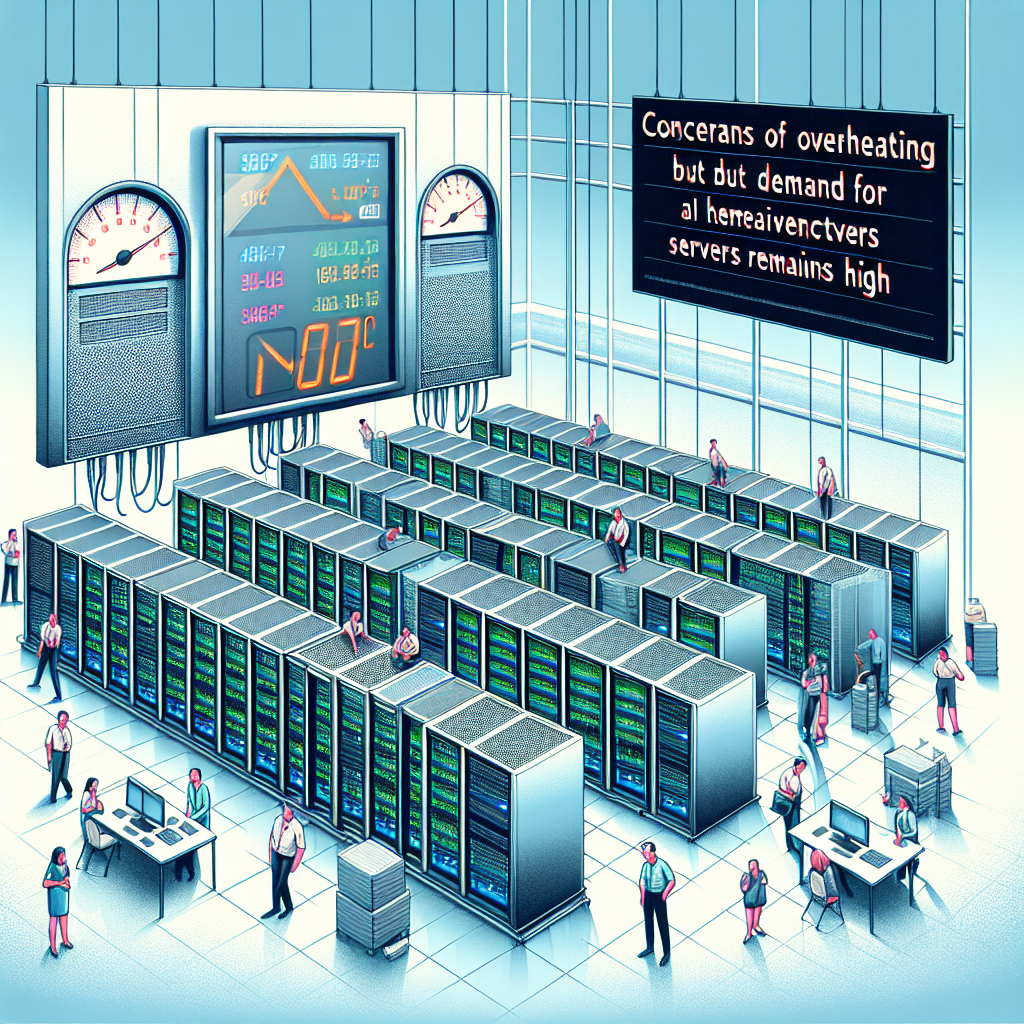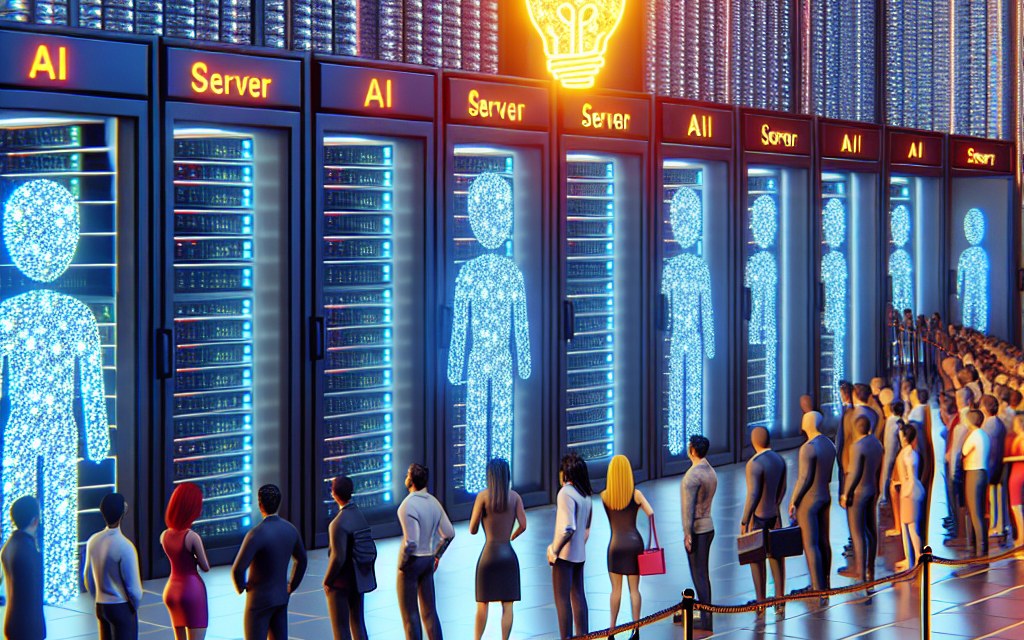“AI Servers Stay Hot, Demand Stays Hotter: Nvidia’s Overheating Concerns Won’t Cool the Market.”
Introduction
Nvidia, a leading player in the semiconductor industry, has recently faced scrutiny over potential overheating issues in its high-performance graphics processing units (GPUs). Despite these concerns, the demand for AI servers, which heavily rely on Nvidia’s cutting-edge technology, remains robust. The company’s GPUs are integral to the development and deployment of artificial intelligence applications, providing the computational power necessary for complex data processing tasks. As industries increasingly adopt AI-driven solutions, the need for reliable and efficient server infrastructure continues to grow. While overheating concerns may prompt Nvidia to enhance its thermal management solutions, the overall demand for AI servers is expected to remain strong, driven by the relentless pursuit of innovation and efficiency in AI technologies.
Impact Of Nvidia Overheating Issues On AI Server Market Growth
Nvidia, a leading player in the semiconductor industry, has recently faced scrutiny over reports of overheating issues in some of its high-performance graphics processing units (GPUs). These concerns have sparked discussions about the potential impact on the burgeoning AI server market, where Nvidia’s products are integral. However, despite these challenges, the demand for AI servers is unlikely to wane, driven by the relentless pursuit of technological advancement and the critical role these servers play in various industries.
To begin with, it is essential to understand the context in which Nvidia operates. The company has established itself as a dominant force in the AI and machine learning sectors, with its GPUs being the backbone of many AI servers. These servers are crucial for processing vast amounts of data, enabling complex computations, and supporting the development of AI models. As industries increasingly rely on AI for innovation and efficiency, the demand for robust and reliable AI servers continues to grow.
While the overheating issues have raised valid concerns, it is important to note that Nvidia has a track record of addressing technical challenges effectively. The company has already initiated measures to mitigate these issues, including software updates and hardware modifications. Moreover, Nvidia’s commitment to research and development ensures that it remains at the forefront of technological advancements, continuously improving its products to meet the evolving needs of the market.
Furthermore, the AI server market is characterized by its rapid growth and diversification. Companies across various sectors, from healthcare to finance, are investing heavily in AI infrastructure to gain a competitive edge. This widespread adoption of AI technologies underscores the resilience of the market, which is unlikely to be significantly affected by isolated technical issues. In fact, the demand for AI servers is expected to continue its upward trajectory, driven by the increasing integration of AI into everyday business operations.
In addition to Nvidia’s proactive approach to resolving the overheating concerns, the broader ecosystem of AI server manufacturers and developers plays a crucial role in sustaining market growth. Many companies are exploring alternative solutions and diversifying their hardware options to ensure reliability and performance. This collaborative effort within the industry not only addresses current challenges but also fosters innovation and resilience, further solidifying the market’s growth prospects.
Moreover, the strategic partnerships and collaborations that Nvidia has established with other technology leaders enhance its ability to navigate these challenges. By working closely with partners, Nvidia can leverage collective expertise and resources to develop more efficient and reliable solutions. This collaborative approach not only benefits Nvidia but also strengthens the entire AI server ecosystem, ensuring that it remains robust and capable of meeting the increasing demands of the market.
In conclusion, while Nvidia’s overheating issues have garnered attention, they are unlikely to significantly impact the growth of the AI server market. The company’s proactive measures, coupled with the industry’s collaborative efforts and the relentless demand for AI technologies, ensure that the market remains resilient and poised for continued expansion. As AI continues to transform industries and drive innovation, the demand for high-performance AI servers will persist, underscoring the critical role that companies like Nvidia play in shaping the future of technology.
Strategies To Mitigate Nvidia Overheating In AI Servers
As the demand for artificial intelligence (AI) servers continues to surge, Nvidia remains at the forefront of this technological revolution, providing the powerful graphics processing units (GPUs) that drive these systems. However, recent concerns about overheating in Nvidia’s GPUs have raised questions about the potential impact on AI server demand. Despite these concerns, it is unlikely that the demand for AI servers will wane, as strategies to mitigate overheating are being actively developed and implemented.
To begin with, it is essential to understand the root causes of overheating in Nvidia GPUs. These high-performance components are designed to handle intensive computational tasks, which generate significant amounts of heat. When not properly managed, this heat can lead to reduced performance, hardware damage, and even system failures. Consequently, addressing overheating is crucial to maintaining the reliability and efficiency of AI servers.
One effective strategy to mitigate overheating is the implementation of advanced cooling solutions. Liquid cooling systems, for instance, have gained popularity due to their ability to dissipate heat more efficiently than traditional air cooling methods. By circulating a coolant through a closed loop, these systems can maintain optimal operating temperatures for GPUs, thereby enhancing performance and extending the lifespan of the hardware. Additionally, the use of thermal interface materials, such as thermal pastes and pads, can improve heat transfer between the GPU and its cooling solution, further reducing the risk of overheating.
Moreover, optimizing the design and layout of AI servers can also play a significant role in managing heat generation. By strategically placing components to maximize airflow and minimize heat accumulation, server manufacturers can enhance the overall thermal performance of their systems. This approach not only helps in preventing overheating but also contributes to energy efficiency, as less power is required to maintain optimal temperatures.
In addition to hardware-based solutions, software optimization is another critical aspect of mitigating overheating in Nvidia GPUs. By fine-tuning the algorithms and workloads that run on these GPUs, developers can reduce the computational intensity and, consequently, the heat generated during operation. Techniques such as dynamic voltage and frequency scaling (DVFS) allow for the adjustment of power consumption based on workload demands, thereby preventing excessive heat buildup.
Furthermore, Nvidia itself is actively working to address overheating concerns through continuous innovation and product development. The company is investing in research to enhance the thermal performance of its GPUs, exploring new materials and designs that can better withstand the demands of AI workloads. These efforts are expected to yield more robust and efficient GPUs, further solidifying Nvidia’s position as a leader in the AI server market.
In conclusion, while overheating concerns in Nvidia GPUs are valid, they are unlikely to significantly impact the demand for AI servers. Through a combination of advanced cooling solutions, optimized server designs, software enhancements, and ongoing innovation from Nvidia, the industry is well-equipped to address these challenges. As AI continues to permeate various sectors, the demand for powerful and reliable AI servers will persist, driving further advancements in GPU technology and thermal management strategies. Consequently, stakeholders can remain confident in the continued growth and evolution of the AI server market, with Nvidia playing a pivotal role in shaping its future.
Nvidia’s Role In The Future Of AI Server Technology
Nvidia has long been a pivotal player in the realm of artificial intelligence, with its graphics processing units (GPUs) serving as the backbone for AI server technology. As the demand for AI capabilities continues to surge across various industries, Nvidia’s role in shaping the future of AI server technology becomes increasingly significant. However, recent concerns about overheating in some of Nvidia’s high-performance GPUs have raised questions about the potential impact on the company’s market position and the broader AI server landscape. Despite these concerns, it is unlikely that they will significantly dampen the demand for AI servers powered by Nvidia technology.
To understand why Nvidia’s position remains strong, it is essential to consider the broader context of AI server demand. The proliferation of AI applications, from autonomous vehicles to advanced data analytics, has created an insatiable appetite for computational power. Nvidia’s GPUs are uniquely suited to meet this demand due to their parallel processing capabilities, which allow for efficient handling of complex AI algorithms. This technological advantage has positioned Nvidia as a leader in the AI server market, with its products being integral to the infrastructure of major tech companies and research institutions worldwide.
While the overheating concerns are not to be dismissed, they must be viewed in perspective. Overheating is a common challenge in high-performance computing, and Nvidia is not the first company to face such issues. The company has a track record of addressing technical challenges through innovation and engineering solutions. For instance, Nvidia has already begun implementing design changes and software updates to mitigate overheating risks in its latest GPU models. These proactive measures demonstrate Nvidia’s commitment to maintaining the reliability and performance of its products, thereby reassuring its customer base.
Moreover, the demand for AI servers is driven by factors that extend beyond the technical specifications of individual components. Organizations investing in AI infrastructure are often motivated by strategic considerations, such as the need to maintain competitive advantage, enhance operational efficiency, and unlock new revenue streams. Nvidia’s GPUs, with their proven performance and scalability, remain an attractive choice for companies seeking to leverage AI technologies. The company’s strong ecosystem, which includes robust software support and a wide range of development tools, further solidifies its appeal to developers and enterprises alike.
In addition to addressing technical concerns, Nvidia is also actively expanding its product offerings to cater to the evolving needs of the AI market. The introduction of new GPU architectures and AI-specific hardware accelerators underscores Nvidia’s commitment to innovation and its ability to adapt to changing market dynamics. This forward-looking approach ensures that Nvidia remains at the forefront of AI server technology, even as new competitors enter the market.
In conclusion, while overheating concerns present a challenge, they are unlikely to significantly impact the demand for Nvidia-powered AI servers. The company’s strong market position, coupled with its proactive measures to address technical issues and its ongoing commitment to innovation, ensures that Nvidia will continue to play a crucial role in the future of AI server technology. As industries increasingly rely on AI to drive growth and transformation, Nvidia’s GPUs will remain a key enabler of this technological revolution, reinforcing the company’s status as a leader in the field.
AI Server Demand Trends Amid Nvidia Overheating Concerns

The rapid advancement of artificial intelligence (AI) technologies has significantly increased the demand for high-performance computing solutions, with Nvidia emerging as a key player in this domain. As AI applications continue to proliferate across various industries, the need for robust and efficient AI servers has become more pronounced. However, recent concerns regarding the overheating of Nvidia’s graphics processing units (GPUs) have raised questions about the potential impact on the demand for AI servers. Despite these concerns, it appears that the demand for AI servers is unlikely to wane, driven by several compelling factors.
To begin with, the global AI market is experiencing unprecedented growth, fueled by the increasing adoption of AI technologies in sectors such as healthcare, finance, automotive, and entertainment. This surge in AI applications necessitates the deployment of powerful computing infrastructure capable of handling complex algorithms and large datasets. Nvidia’s GPUs, renowned for their superior performance and efficiency, have become the go-to choice for many organizations seeking to harness the power of AI. Consequently, the demand for AI servers equipped with Nvidia GPUs remains robust, as businesses prioritize performance and reliability over potential overheating issues.
Moreover, Nvidia has been proactive in addressing the overheating concerns associated with its GPUs. The company has implemented several measures to mitigate these issues, including the development of advanced cooling solutions and the optimization of power management features. These efforts have been well-received by the industry, instilling confidence in Nvidia’s ability to deliver reliable and efficient products. As a result, many organizations continue to invest in AI servers powered by Nvidia GPUs, reassured by the company’s commitment to resolving any technical challenges.
In addition to Nvidia’s proactive measures, the broader technological landscape is also contributing to sustained demand for AI servers. The advent of edge computing, for instance, is driving the need for decentralized AI processing capabilities, further bolstering the demand for high-performance servers. Edge computing enables data processing closer to the source, reducing latency and improving efficiency. This paradigm shift is particularly relevant for applications such as autonomous vehicles and smart cities, where real-time data processing is critical. Nvidia’s GPUs, with their ability to deliver exceptional performance in edge environments, are well-positioned to capitalize on this trend, thereby maintaining strong demand for AI servers.
Furthermore, the competitive landscape in the AI hardware market is evolving, with several companies vying for a share of the lucrative AI server segment. This competition is fostering innovation and driving improvements in GPU technology, ultimately benefiting end-users. As companies strive to outpace one another, the focus remains on enhancing performance, efficiency, and reliability. Consequently, organizations are likely to continue investing in AI servers, confident that the industry will address any technical challenges, including overheating concerns.
In conclusion, while Nvidia’s overheating concerns have garnered attention, they are unlikely to significantly impact the demand for AI servers. The burgeoning AI market, coupled with Nvidia’s proactive measures and the broader technological trends, ensures that the demand for high-performance computing solutions remains strong. As organizations increasingly rely on AI to drive innovation and efficiency, the need for reliable and efficient AI servers will continue to grow, underscoring the resilience of this market segment.
Technological Innovations To Address Nvidia Overheating
Nvidia, a leading name in the world of graphics processing units (GPUs) and artificial intelligence (AI) hardware, has recently faced scrutiny over concerns regarding the overheating of its products. Despite these concerns, the demand for AI servers, which heavily rely on Nvidia’s technology, remains robust. This situation presents an intriguing intersection of technological innovation and market dynamics, as Nvidia and its partners work diligently to address these overheating issues while maintaining the momentum of AI server adoption.
To begin with, it is essential to understand the root of the overheating concerns. Nvidia’s GPUs are renowned for their high performance, which is crucial for AI applications that require substantial computational power. However, this high performance comes with increased heat generation, a common challenge in the semiconductor industry. As AI models grow more complex, the demand for processing power intensifies, leading to higher thermal output. Consequently, managing this heat becomes a critical aspect of maintaining the reliability and efficiency of AI servers.
In response to these challenges, Nvidia has been proactive in developing innovative cooling solutions. One such approach involves the integration of advanced thermal management technologies, such as liquid cooling systems, which are more effective than traditional air cooling methods. Liquid cooling not only enhances heat dissipation but also allows for more compact server designs, which is a significant advantage in data centers where space is at a premium. Furthermore, Nvidia is collaborating with server manufacturers to optimize the design and layout of AI servers, ensuring that airflow and heat distribution are maximized.
Moreover, Nvidia’s commitment to addressing overheating concerns extends beyond hardware solutions. The company is also investing in software innovations that optimize the performance of its GPUs. By refining algorithms and enhancing power management features, Nvidia aims to reduce the thermal load on its processors without compromising computational capabilities. These software advancements are crucial in ensuring that AI servers can operate efficiently under demanding workloads.
Despite the technical challenges posed by overheating, the demand for AI servers continues to surge. This demand is driven by the rapid adoption of AI technologies across various industries, including healthcare, finance, and autonomous vehicles. Organizations are increasingly recognizing the transformative potential of AI, leading to a growing need for powerful computing infrastructure. Nvidia’s GPUs, with their unparalleled performance, remain a preferred choice for AI server deployments, underscoring the resilience of the market.
Furthermore, the broader ecosystem surrounding AI servers is evolving to support Nvidia’s efforts. Data center operators are investing in infrastructure upgrades to accommodate the thermal requirements of high-performance computing systems. This includes the implementation of advanced cooling technologies and the redesign of data center layouts to enhance airflow and heat management. These developments highlight the collaborative nature of the industry, as stakeholders work together to overcome the challenges associated with AI server deployment.
In conclusion, while Nvidia’s overheating concerns present a technical challenge, they are unlikely to dampen the demand for AI servers. Through a combination of hardware and software innovations, Nvidia is actively addressing these issues, ensuring that its GPUs continue to deliver the performance required for cutting-edge AI applications. As the AI landscape evolves, the industry’s collective efforts to enhance thermal management will play a pivotal role in sustaining the growth and adoption of AI technologies. Consequently, Nvidia remains well-positioned to capitalize on the burgeoning demand for AI servers, reinforcing its status as a leader in the field of technological innovation.
Market Analysis: Nvidia’s Position In AI Server Industry
Nvidia Corporation, a leading player in the semiconductor industry, has been at the forefront of the artificial intelligence (AI) revolution, particularly in the realm of AI servers. Despite recent concerns regarding overheating issues in some of its high-performance graphics processing units (GPUs), the demand for Nvidia’s products in the AI server market remains robust. This resilience can be attributed to several factors that underscore Nvidia’s strong position in the industry.
To begin with, Nvidia’s GPUs are renowned for their unparalleled performance in AI applications. These GPUs are integral to the training and deployment of complex machine learning models, which are increasingly being adopted across various sectors, including healthcare, finance, and autonomous vehicles. The company’s cutting-edge technology has set a benchmark in the industry, making it a preferred choice for enterprises seeking to harness the power of AI. Consequently, even as concerns about overheating persist, the performance benefits offered by Nvidia’s GPUs continue to outweigh potential drawbacks for many users.
Moreover, Nvidia has demonstrated a proactive approach in addressing the overheating issues. The company has been quick to acknowledge the problem and has committed to implementing solutions that mitigate the risks associated with overheating. This includes software updates and hardware modifications designed to enhance thermal management. By taking these steps, Nvidia not only reassures its existing customer base but also reinforces its reputation as a reliable and innovative leader in the AI server market.
In addition to its technical prowess, Nvidia’s strategic partnerships and acquisitions have further solidified its position in the industry. The company’s acquisition of Mellanox Technologies, a leader in high-performance computing and networking solutions, has expanded its capabilities and product offerings. This acquisition has enabled Nvidia to provide comprehensive solutions that integrate both processing power and data transfer efficiency, which are critical for AI server performance. Such strategic moves have allowed Nvidia to maintain a competitive edge, even as new players enter the market.
Furthermore, the global demand for AI-driven solutions continues to grow at an unprecedented rate. Organizations are increasingly investing in AI infrastructure to gain insights from vast amounts of data and to automate complex processes. This trend is expected to drive sustained demand for AI servers, and by extension, Nvidia’s GPUs. The company’s ability to innovate and adapt to evolving market needs positions it well to capitalize on this growing demand.
It is also important to consider the broader context of the semiconductor industry, which is characterized by rapid technological advancements and intense competition. In this dynamic environment, Nvidia’s commitment to research and development ensures that it remains at the cutting edge of innovation. The company’s focus on developing next-generation GPUs that offer improved performance and energy efficiency is likely to address current concerns and meet future market demands.
In conclusion, while overheating concerns present a challenge for Nvidia, they are unlikely to significantly impact the demand for its products in the AI server market. The company’s strong performance, proactive problem-solving, strategic initiatives, and the overarching growth of AI applications collectively reinforce its dominant position. As Nvidia continues to innovate and adapt, it is well-positioned to navigate the challenges and opportunities that lie ahead in the AI server industry.
Long-term Implications Of Nvidia Overheating On AI Development
Nvidia, a leading player in the semiconductor industry, has recently faced scrutiny over reports of overheating issues in some of its high-performance graphics processing units (GPUs). These concerns have sparked discussions about the potential long-term implications for artificial intelligence (AI) development, given Nvidia’s pivotal role in powering AI servers. However, despite these overheating concerns, the demand for AI servers is unlikely to wane, as the broader trajectory of AI development remains robust and resilient.
To begin with, it is essential to understand the context in which Nvidia operates. The company has established itself as a cornerstone in the AI ecosystem, providing the computational power necessary for training complex machine learning models. Its GPUs are renowned for their ability to handle large-scale data processing tasks, making them indispensable for AI researchers and developers. Consequently, any technical issues with Nvidia’s products naturally raise questions about potential disruptions in AI progress.
Nevertheless, the overheating concerns, while noteworthy, are unlikely to have a significant long-term impact on AI development. This is primarily because the demand for AI capabilities continues to grow exponentially across various sectors, including healthcare, finance, and autonomous vehicles. Organizations are increasingly recognizing the transformative potential of AI, driving investments in AI infrastructure and solutions. As a result, the appetite for high-performance computing resources remains insatiable, ensuring that Nvidia’s products will continue to be in high demand.
Moreover, Nvidia has a track record of addressing technical challenges effectively. The company has consistently demonstrated its ability to innovate and adapt, ensuring that its products meet the evolving needs of the market. In response to the overheating concerns, Nvidia is likely to implement design improvements and software optimizations to mitigate these issues. Such proactive measures will not only address current concerns but also reinforce confidence in Nvidia’s commitment to delivering reliable and efficient solutions.
In addition to Nvidia’s efforts, the broader AI community is characterized by its collaborative nature. Researchers and developers often work together to overcome technical hurdles, sharing insights and solutions that benefit the entire ecosystem. This collaborative spirit ensures that any potential setbacks, such as overheating issues, are addressed collectively, minimizing their impact on AI development. Furthermore, the diversity of players in the AI hardware market means that alternative solutions are readily available, providing additional resilience against any single point of failure.
It is also important to consider the rapid pace of technological advancement in the AI field. Innovations in cooling technologies, energy-efficient architectures, and distributed computing are continually emerging, offering new ways to enhance the performance and reliability of AI servers. These advancements provide a buffer against potential hardware limitations, ensuring that AI development can continue unabated.
In conclusion, while Nvidia’s overheating concerns warrant attention, they are unlikely to dampen the demand for AI servers or impede the long-term progress of AI development. The sustained growth in AI applications, coupled with Nvidia’s proactive approach and the collaborative nature of the AI community, ensures that any challenges will be addressed effectively. As technology continues to evolve, the resilience and adaptability of the AI ecosystem will remain key drivers of its ongoing success.
Q&A
1. **What are the primary concerns regarding Nvidia’s overheating issues?**
The primary concerns involve potential hardware failures and reduced performance in Nvidia’s GPUs due to overheating, which could affect their reliability and lifespan.
2. **How might overheating issues impact Nvidia’s reputation?**
Overheating issues could harm Nvidia’s reputation for producing high-quality, reliable hardware, potentially leading to customer dissatisfaction and loss of trust.
3. **What measures is Nvidia taking to address overheating concerns?**
Nvidia is likely implementing hardware and software solutions, such as improved cooling systems and firmware updates, to mitigate overheating issues.
4. **Why is AI server demand unlikely to be affected by Nvidia’s overheating issues?**
The demand for AI servers is driven by the rapid growth of AI applications and the need for high-performance computing, which outweighs concerns over potential hardware issues.
5. **What role do Nvidia’s GPUs play in AI server infrastructure?**
Nvidia’s GPUs are critical for AI server infrastructure due to their superior processing power and efficiency in handling complex AI computations and workloads.
6. **How are data centers managing potential overheating in Nvidia GPUs?**
Data centers are employing advanced cooling technologies and monitoring systems to manage and prevent overheating in Nvidia GPUs, ensuring optimal performance.
7. **What is the long-term outlook for Nvidia despite overheating concerns?**
The long-term outlook for Nvidia remains positive due to its strong market position, continuous innovation, and the growing demand for AI and high-performance computing solutions.
Conclusion
Nvidia’s overheating concerns, while noteworthy, are unlikely to significantly impact the demand for AI servers. The company’s dominant position in the AI hardware market, driven by its advanced GPU technology, continues to attract substantial interest from industries seeking to leverage AI capabilities. Despite potential thermal management issues, the overall demand for AI servers remains robust due to the increasing adoption of AI across various sectors. Nvidia’s ongoing efforts to address these concerns and its strong reputation for innovation and performance are expected to mitigate any potential negative effects on its market position. As a result, the demand for AI servers is projected to remain strong, driven by the growing need for AI-driven solutions and Nvidia’s continued leadership in the field.





